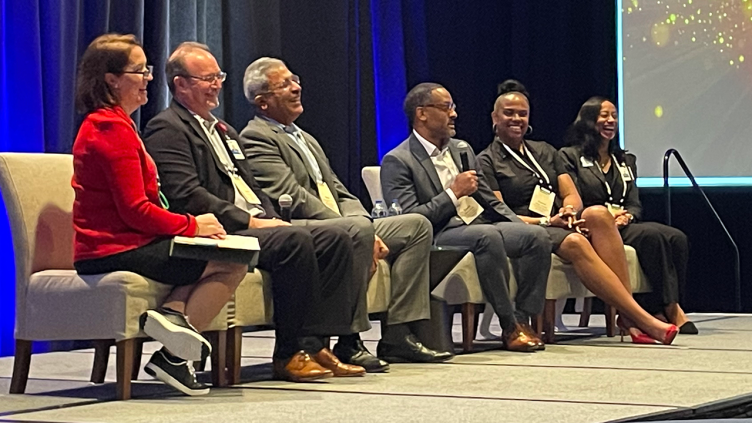How to Succeed at Health Equity Fundraising
Jenny Love
Published: 04/12/2023

From left to right: Alice Ayres interviews David Collis, Dr. Rajan Wadhawan, David Daniels, Felicia DeHaney, and Aflreda Clark about the creation of the AdventHealth for Children’s West Lakes Early Learning Center.
Two weeks ago at the AHP Leading Forward Health Equity Summit, foundation leaders from around the country explored how healthcare philanthropy can bridge the gap to meet community needs without sacrificing momentum on traditional projects. Below are some of the great insights they shared.
Educate Your Staff
Fundraising for health equity requires different skills than raising money for a new hospital wing. Gift officers need to be able to sell donors on something they can’t necessarily see or touch and that pays dividends over a longer period than many traditional projects. They also need to understand what health equity means, how it is different from equality, and most importantly why it is necessary in our communities and important to our future. The same is true for your board, hospital leadership, and clinicians.
And Your Donors
Like staff at your organization, your donors may also need education on what health equity is and why it matters. Storytelling is always important in impact reporting, and it’s especially true for community-based projects. Karen Berube, MSW, LCSW, CSAC, chief of community health and health equity and senior vice president at Inova Health System, advocates reaching out to participants in your community initiatives to tell their stories. Data and statistics about your new clinic can’t compete with a story of a man crying on the phone to his mother that he is “finally in a real doctor’s office."
Build Support at the Top
Virtually all of the conference speakers credited their success in part to strong relationships with and support from the CEO and/or fundraising board of their organization. When senior leadership understands the value of and need for the hospital to play a strong role in the health of the community outside the hospital walls, resources follow. This support is especially crucial at a time when many hospitals are facing financial strain, and resources for projects outside the core business can be difficult to come by. Invest time in your relationship with your CEO and in making them a partner and advocate for your health equity work.
Let the Community Lead the Way
Donors, hospital leadership, clinicians, or others may have well-meaning ideas for initiatives to pursue to further health equity goals, but there's no substitute for engaging members of the community you serve directly to determine the best way to proceed. As Jyesha Wren, Nurse Midwife, program director at BElovedBIRTH Black Centering, put it, the people impacted by the problems have the most experience with them and the best solutions to them. Let them tell you what they need, and then organize fundraising efforts around it, not the other way around.
When you embark on a health equity focused project, hire staff from the community too. Trust comes from strong relationships.
Don't Reinvent the Wheel
While it's critical that the community tells you what they need, that doesn't mean you have to start from scratch on implementation. Instead, lean on the successes of others who have tackled these problems successfully before you. For example, Crystal Hinson Miller, MA, FAHP, CFRE and Jami Marsh used the LISC financial opportunity center model as the basis for their own center, altering it to meet the specific needs their community identified. Rippel Foundation, which focuses on achieving health and well being for all that is sustainable and equitable, also has a number of frameworks to help you navigate your way forward.
Invest in Coordination
Many health equity projects require partnerships among multiple organizations for both funding and execution to succeed. Coordination and communication among all the partners is critical and worth investing in, even if it means adding some dreaded overhead. Sarah Owen, CEO of Collaboratory suggests looking at NASA in the 1960s when it committed to put a man on the moon. NASA itself didn’t produce anything itself; rather, its job was to coordinate among many other organizations to enable great things that no single one of the organizations could have achieved alone. Coordination isn’t overhead; it’s essential.
Leave Your Ego at the Door
Even with coordination, when you bring multiple organizations with varying strategies and goals together, there’s bound to be areas of disagreement. It’s critical to deemphasize the individual interests of partners and remain focused on the mission. When tensions rise, try to remember that everyone involved is a real person trying to do good things. Take a look at your community as a whole, see the problems together, and set a common goal.
Advocate for Reimbursement Reform
Research shows that 80% of health is determined outside the hospital walls, but U.S. payers currently only cover the 20% that occurs within them. We want to expand our reach into the 80%, but the U.S. healthcare system is not set up for that. As David Aylward put it, right now we are asking payers with a short-term ROI mindset to think like long-term investors. While there is opportunity to prove that initiatives to decrease food deserts or improve housing lower per member per month expenditures for insured populations, ultimately a more drastic change to the American system is needed to incentivize these types of initiatives, make a significant dent in healthcare costs, and improve the whole health and well being of Americans.